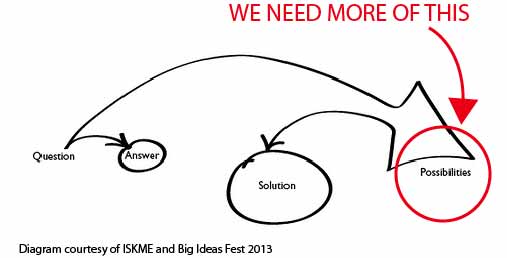By Kate Ganim
Have you ever noticed that the way students are evaluated by teachers looks oddly similar to the way teachers are evaluated by administrators? Have you ever seen the parallel between administrators’ mandates being resisted by teachers and teachers’ mandates being resisted by students? Teachers decry the difficulties of classroom management, but have you ever tried to manage a classroom of teachers?
The school reinforces certain values and expectations in teachers and students alike. Which makes sense - it’s all part of the same ecosystem, after all.
The values and expectations that have been common to the traditional school include: a top-down flow of orders and information, a singular definition of “intelligence” as measured by standardized tests, responding to failure with punishment, and a focus on facts and figures.
Great thinkers such as Ken Robinson have described this “factory” model of learning, as reinforcing students to be obedient and homogenous. This model proved very successful for preparing students to enter the Industrial Era workforce in repetitive factory jobs. Its relevance has waned as the Era of Information has risen.
Those same values - obedience and homogeneity - have been reinforced in teachers over the years. For over a decade, The No Child Left Behind Act has given teachers clear directives on what to teach and how to teach it.
We are faced with a tremendous opportunity for mainstream education. Common Core is an invitation for cultural shift, for the school to bring its values and expectations up-to-date with the demands of this century’s job market.
Most states are requiring their teachers to implement Common Core in their classrooms. After years of clear directives on how to teach, teachers have suddenly been granted the freedom to teach how they want. Under Common Core, in addition to teaching students what they should know (knowledge), teachers are tasked with teaching students how to think (skills) “for success in college and careers.” Take, for example, Common Core Standard CCSS.Math.Practice.MP1: to “Make sense of problems and persevere in solving them.” Who wouldn’t benefit from this skill in today’s world?
We recently had the opportunity to witness how educators are responding to Common Core, and to brainstorm approaches for its implementation. This happened at the Big Ideas Fest 2013 Conference, hosted by ISKME, in active breakout sessions called “Action Collabs.” These sessions were interspersed with TED-style talks, providing an innovative and compelling space to explore ideas with fellow conference-goers and take meaningful, collaborative action on important issues in education today. It was an incredibly powerful format: get riled up from inspiring talks, and then pour that energy into brainstorming real-world solutions. (Kudos to ISKME for developing such a brilliant and effective approach!)
The consensus in our Action Collab was that educators are feeling panicked, confused, and unsupported by the new standards, and are grasping for more concrete direction. At the same time, they recognize the potential for innovation with the new standards, and are interested in finding a more effective approach.
The instinct of most educators is to jump to thinking about the student and the student’s experience, looking to make a remix of innovative solutions that have precedence within education. There were inspiring and exciting ideas abound. I think that all of the ideas we discussed could have worked.
I’m not sure that’s a good thing.
Leo F. Buscaglia said, “We seem to gain wisdom more readily through our failures than through our successes. We always think of failure as the antithesis of success, but it isn’t. Success often lies just the other side of failure.”
The onus is on educators and administrators to instigate the cultural shift invited by Common Core, and to offer each other support in doing so. What values and expectations do you want your school to impart?
Today’s “successful” student is a critical thinker and creative problem solver, who is able to work collaboratively, discover the answers to her own questions, adapt quickly and confidently to change, and who has technological fluency.
I would describe today’s “successful” educator and administrator in the same way.
Educators and administrators: Cultivate those 21st Century values and expectations in yourself. These are the skills that you will need in order to re-envision what you do and how you do it.
Experiment. Use the 21st Century skills we expect of our students (eg, CCSS.Math.Practice.MP1 “Make sense of problems and persevere in solving them.”) to hack your syllabus. Test your ideas in the classroom. Recognize that you will never discover your limits without pushing them to the point of failure - you can always scale back from there. No idea is perfect the first time around - progress comes most quickly from rapidly testing a lot of ideas: fail fast, and fail often. If you’re having fun testing an idea out, chances are good that your students will be engaged with it, as well. And if they’re not engaged, use those critical thinking and adaptability skills of yours to figure out why it didn’t work and how you can make it better. Take advantage of the incredible resources and communities available online to exchange ideas, like ISKME’s OER, Next.cc, or Howtoons, to name a few.
This is how we will catalyze true change in education.
It will be messy. But messiness can cultivate delight. And exploration. And risk-taking. And plenty of failure.



